Knowledge Management Report: Benefits, Challenges, and Cycle
VerifiedAdded on 2023/04/21
|13
|3233
|184
Report
AI Summary
This report provides a comprehensive overview of knowledge management, detailing its core concepts and practical applications. It begins by defining knowledge management and its importance, emphasizing the distinction between data, information, and knowledge. The report then explores the knowledge cycle, outlining its stages from knowledge demand to use. It includes a case study illustrating the implementation of an ERP system within a courier service company, highlighting the benefits and challenges associated with such technological changes. The report also discusses the importance of communication models, customer knowledge management, and the role of information communication technology (ICT). Finally, it addresses various challenges organizations face in knowledge management, such as security, employee motivation, and the need to adapt to technological advancements. The report offers valuable insights into improving organizational processes and fostering a knowledge-driven environment.
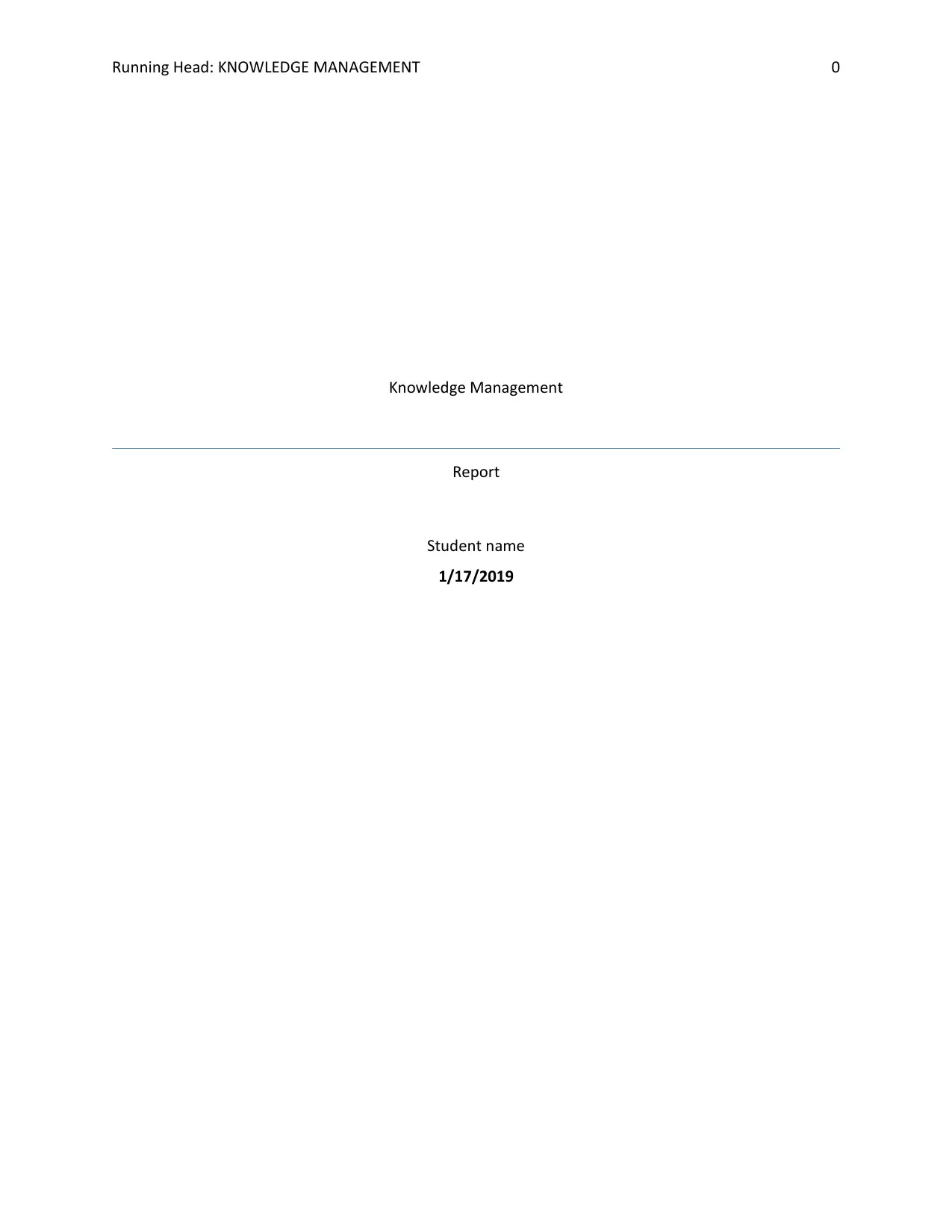
Running Head: KNOWLEDGE MANAGEMENT 0
Knowledge Management
Report
Student name
1/17/2019
Knowledge Management
Report
Student name
1/17/2019
Paraphrase This Document
Need a fresh take? Get an instant paraphrase of this document with our AI Paraphraser
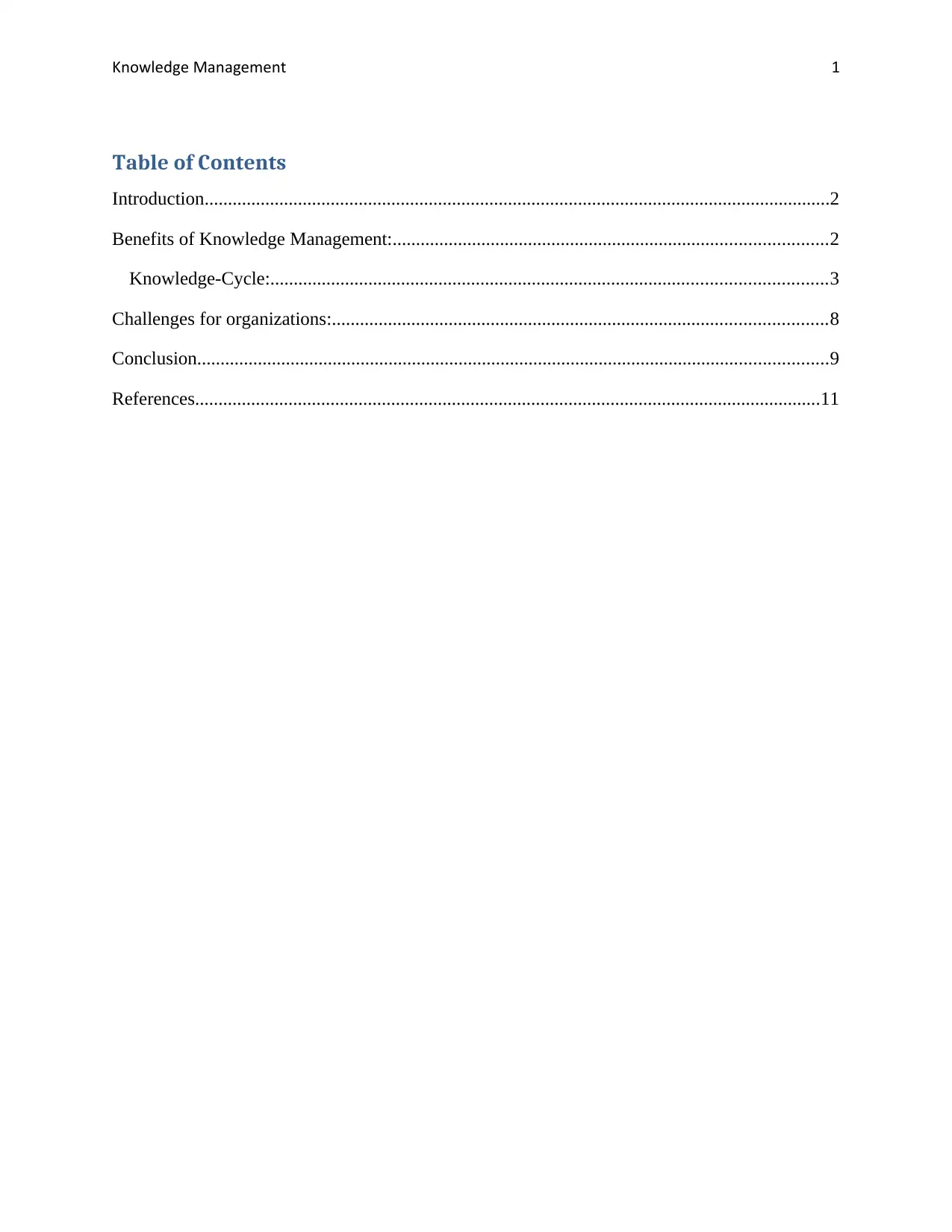
Knowledge Management 1
Table of Contents
Introduction......................................................................................................................................2
Benefits of Knowledge Management:.............................................................................................2
Knowledge-Cycle:.......................................................................................................................3
Challenges for organizations:..........................................................................................................8
Conclusion.......................................................................................................................................9
References......................................................................................................................................11
Table of Contents
Introduction......................................................................................................................................2
Benefits of Knowledge Management:.............................................................................................2
Knowledge-Cycle:.......................................................................................................................3
Challenges for organizations:..........................................................................................................8
Conclusion.......................................................................................................................................9
References......................................................................................................................................11
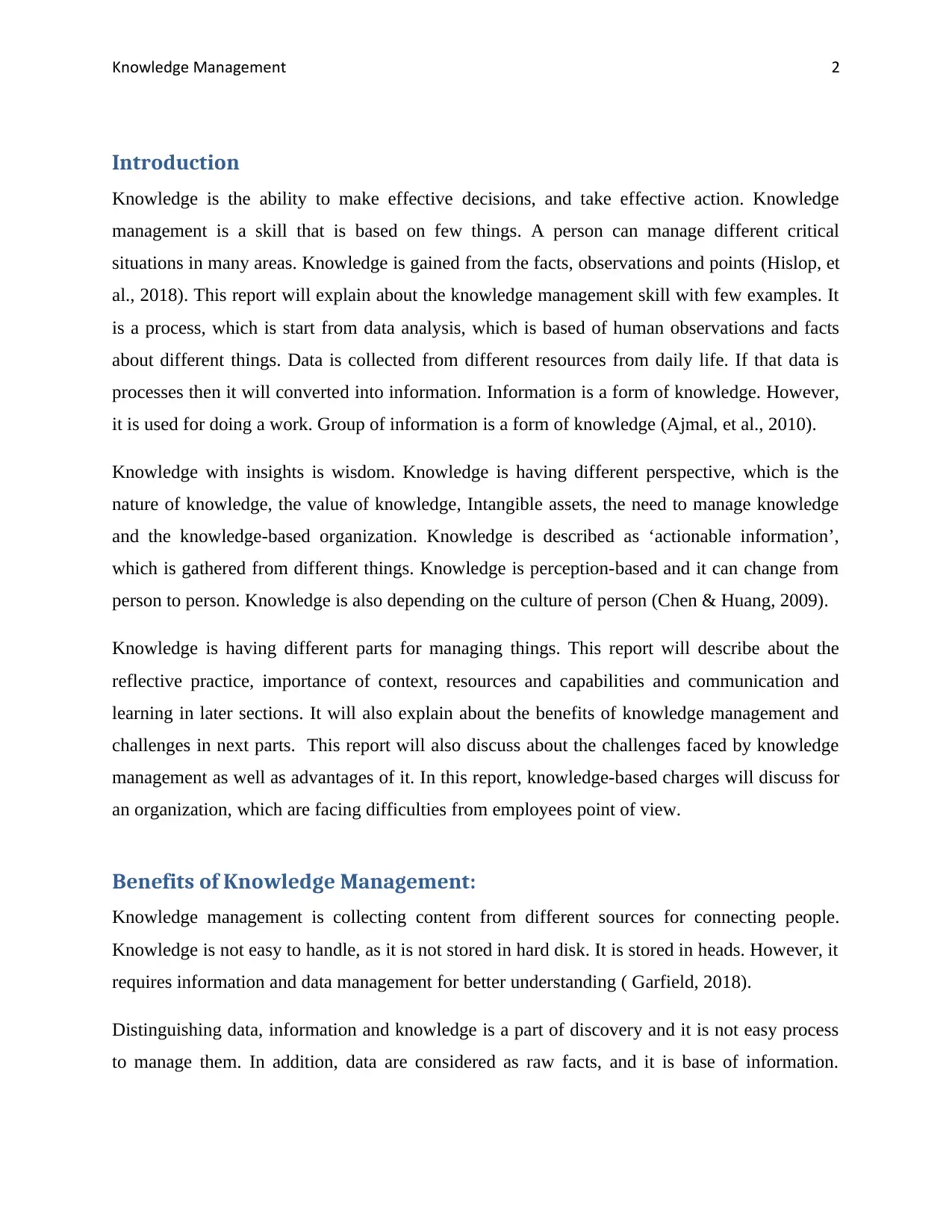
Knowledge Management 2
Introduction
Knowledge is the ability to make effective decisions, and take effective action. Knowledge
management is a skill that is based on few things. A person can manage different critical
situations in many areas. Knowledge is gained from the facts, observations and points (Hislop, et
al., 2018). This report will explain about the knowledge management skill with few examples. It
is a process, which is start from data analysis, which is based of human observations and facts
about different things. Data is collected from different resources from daily life. If that data is
processes then it will converted into information. Information is a form of knowledge. However,
it is used for doing a work. Group of information is a form of knowledge (Ajmal, et al., 2010).
Knowledge with insights is wisdom. Knowledge is having different perspective, which is the
nature of knowledge, the value of knowledge, Intangible assets, the need to manage knowledge
and the knowledge-based organization. Knowledge is described as ‘actionable information’,
which is gathered from different things. Knowledge is perception-based and it can change from
person to person. Knowledge is also depending on the culture of person (Chen & Huang, 2009).
Knowledge is having different parts for managing things. This report will describe about the
reflective practice, importance of context, resources and capabilities and communication and
learning in later sections. It will also explain about the benefits of knowledge management and
challenges in next parts. This report will also discuss about the challenges faced by knowledge
management as well as advantages of it. In this report, knowledge-based charges will discuss for
an organization, which are facing difficulties from employees point of view.
Benefits of Knowledge Management:
Knowledge management is collecting content from different sources for connecting people.
Knowledge is not easy to handle, as it is not stored in hard disk. It is stored in heads. However, it
requires information and data management for better understanding ( Garfield, 2018).
Distinguishing data, information and knowledge is a part of discovery and it is not easy process
to manage them. In addition, data are considered as raw facts, and it is base of information.
Introduction
Knowledge is the ability to make effective decisions, and take effective action. Knowledge
management is a skill that is based on few things. A person can manage different critical
situations in many areas. Knowledge is gained from the facts, observations and points (Hislop, et
al., 2018). This report will explain about the knowledge management skill with few examples. It
is a process, which is start from data analysis, which is based of human observations and facts
about different things. Data is collected from different resources from daily life. If that data is
processes then it will converted into information. Information is a form of knowledge. However,
it is used for doing a work. Group of information is a form of knowledge (Ajmal, et al., 2010).
Knowledge with insights is wisdom. Knowledge is having different perspective, which is the
nature of knowledge, the value of knowledge, Intangible assets, the need to manage knowledge
and the knowledge-based organization. Knowledge is described as ‘actionable information’,
which is gathered from different things. Knowledge is perception-based and it can change from
person to person. Knowledge is also depending on the culture of person (Chen & Huang, 2009).
Knowledge is having different parts for managing things. This report will describe about the
reflective practice, importance of context, resources and capabilities and communication and
learning in later sections. It will also explain about the benefits of knowledge management and
challenges in next parts. This report will also discuss about the challenges faced by knowledge
management as well as advantages of it. In this report, knowledge-based charges will discuss for
an organization, which are facing difficulties from employees point of view.
Benefits of Knowledge Management:
Knowledge management is collecting content from different sources for connecting people.
Knowledge is not easy to handle, as it is not stored in hard disk. It is stored in heads. However, it
requires information and data management for better understanding ( Garfield, 2018).
Distinguishing data, information and knowledge is a part of discovery and it is not easy process
to manage them. In addition, data are considered as raw facts, and it is base of information.
⊘ This is a preview!⊘
Do you want full access?
Subscribe today to unlock all pages.

Trusted by 1+ million students worldwide
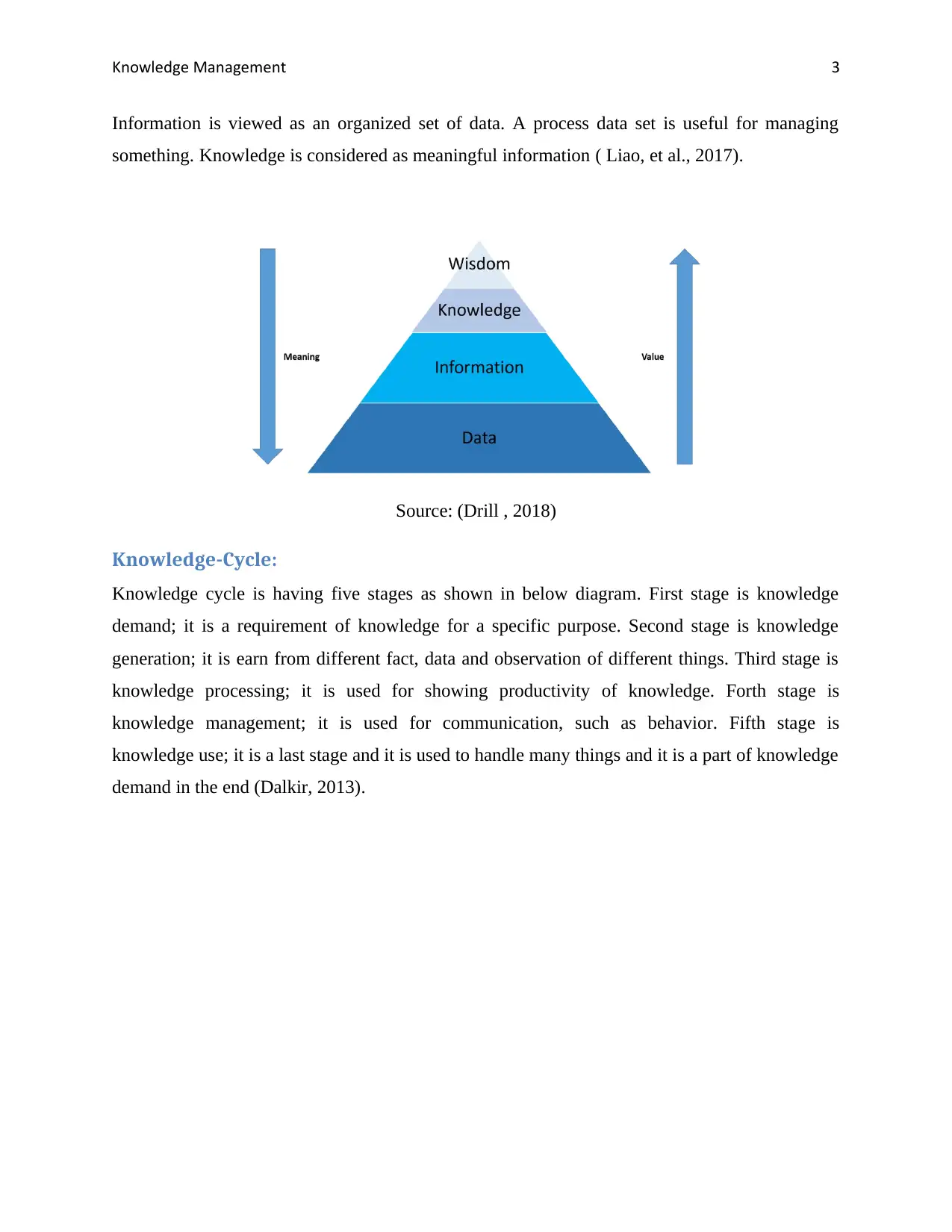
Knowledge Management 3
Information is viewed as an organized set of data. A process data set is useful for managing
something. Knowledge is considered as meaningful information ( Liao, et al., 2017).
Source: (Drill , 2018)
Knowledge-Cycle:
Knowledge cycle is having five stages as shown in below diagram. First stage is knowledge
demand; it is a requirement of knowledge for a specific purpose. Second stage is knowledge
generation; it is earn from different fact, data and observation of different things. Third stage is
knowledge processing; it is used for showing productivity of knowledge. Forth stage is
knowledge management; it is used for communication, such as behavior. Fifth stage is
knowledge use; it is a last stage and it is used to handle many things and it is a part of knowledge
demand in the end (Dalkir, 2013).
Information is viewed as an organized set of data. A process data set is useful for managing
something. Knowledge is considered as meaningful information ( Liao, et al., 2017).
Source: (Drill , 2018)
Knowledge-Cycle:
Knowledge cycle is having five stages as shown in below diagram. First stage is knowledge
demand; it is a requirement of knowledge for a specific purpose. Second stage is knowledge
generation; it is earn from different fact, data and observation of different things. Third stage is
knowledge processing; it is used for showing productivity of knowledge. Forth stage is
knowledge management; it is used for communication, such as behavior. Fifth stage is
knowledge use; it is a last stage and it is used to handle many things and it is a part of knowledge
demand in the end (Dalkir, 2013).
Paraphrase This Document
Need a fresh take? Get an instant paraphrase of this document with our AI Paraphraser
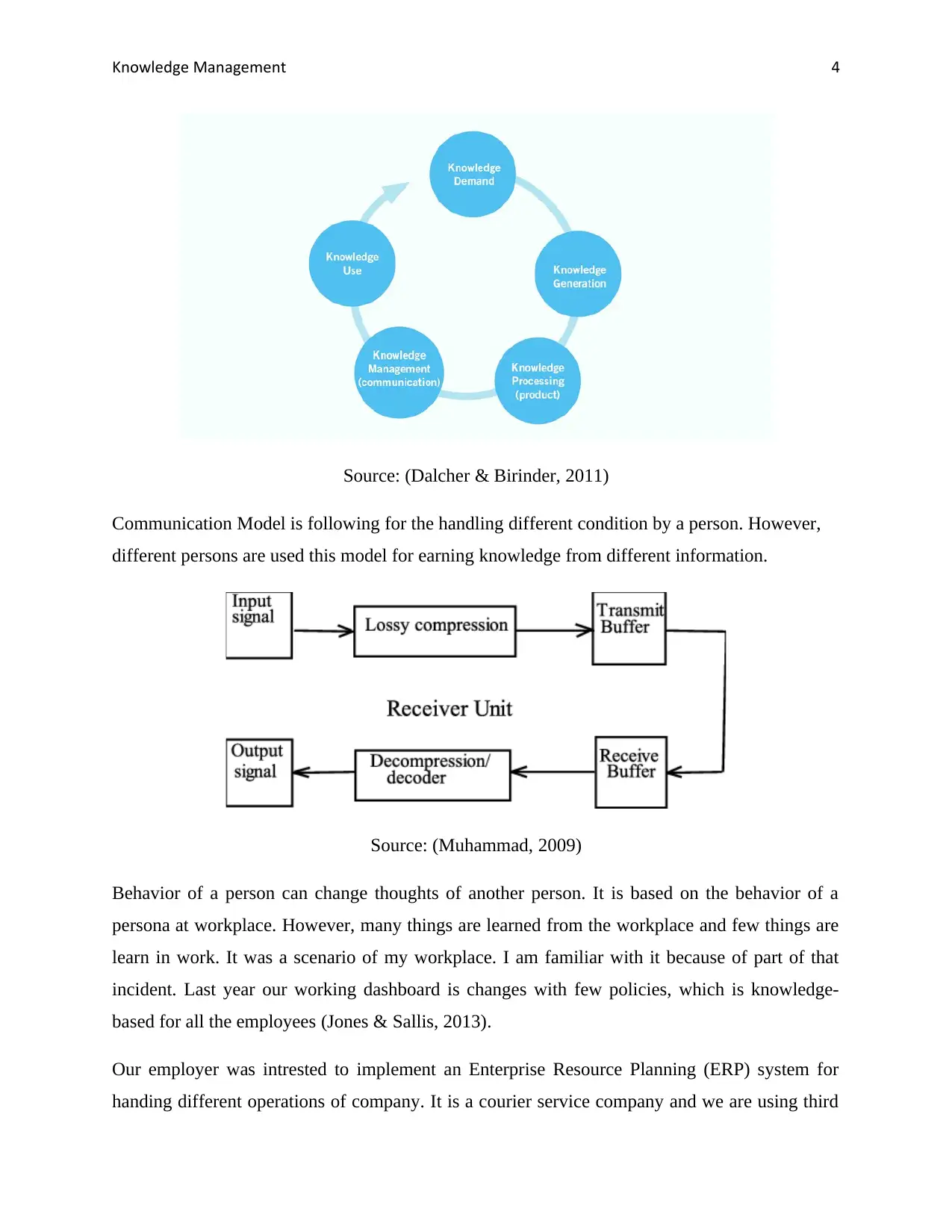
Knowledge Management 4
Source: (Dalcher & Birinder, 2011)
Communication Model is following for the handling different condition by a person. However,
different persons are used this model for earning knowledge from different information.
Source: (Muhammad, 2009)
Behavior of a person can change thoughts of another person. It is based on the behavior of a
persona at workplace. However, many things are learned from the workplace and few things are
learn in work. It was a scenario of my workplace. I am familiar with it because of part of that
incident. Last year our working dashboard is changes with few policies, which is knowledge-
based for all the employees (Jones & Sallis, 2013).
Our employer was intrested to implement an Enterprise Resource Planning (ERP) system for
handing different operations of company. It is a courier service company and we are using third
Source: (Dalcher & Birinder, 2011)
Communication Model is following for the handling different condition by a person. However,
different persons are used this model for earning knowledge from different information.
Source: (Muhammad, 2009)
Behavior of a person can change thoughts of another person. It is based on the behavior of a
persona at workplace. However, many things are learned from the workplace and few things are
learn in work. It was a scenario of my workplace. I am familiar with it because of part of that
incident. Last year our working dashboard is changes with few policies, which is knowledge-
based for all the employees (Jones & Sallis, 2013).
Our employer was intrested to implement an Enterprise Resource Planning (ERP) system for
handing different operations of company. It is a courier service company and we are using third

Knowledge Management 5
party software for communication and managing our work, such as requirements of projects.
There are many things, which are managed on daily basis without any online record. All things
are in registers, which is not safe and secure according to security purpose of confidential matter
(Stehr, 2012).
Our senior managing was ready to implement new software for the management of all the
operations of company in a proper way, such as courier management, payroll management, shift
management, attendance management, and many others (Zack, et al., 2009).
There were so many options presented in the software for handling different processes of the
organization. It was not so difficult for those people who already know computer system
working, but few employees were not agreed for it. Therefore, management was in dilemma to
implement this software or not. It was beneficial for business growth and productivity as well as
services (Firestone & McElroy, 2012).
ERP system was having many functions according to the requirements. It was easier to learn and
work. It was easier than previous system. ERP system was beneficial for management as well as
for employees in different terms. It provided benefits to company in terms of cost and time. It
took less time to monitoring a parcel and it was a better service for users. Clients were required
that type of system, which was providing tracking system for their parcel. There was a huge cost
for that ERP system but it was more beneficial for future time (Bhagat, 2012).
ERP software was cloud based and it was accessible anywhere in the world. It just required a
system and it required internet for work (So, 2011). It was having different parts for user’s admin
and management. Few employees were against it, because of less knowledge about the online
computing and software management. However, company was ready to provide training to all
employees, which is based on their areas (Zheng, et al., 2010).
Knowledge repository is having five stages for managing different things in a proper way. It is a
way to handle all the things. Mayer and Wack analysed different stages of knowledge repository,
which is following Km Cycle stages:
Acquisition
Refinement
party software for communication and managing our work, such as requirements of projects.
There are many things, which are managed on daily basis without any online record. All things
are in registers, which is not safe and secure according to security purpose of confidential matter
(Stehr, 2012).
Our senior managing was ready to implement new software for the management of all the
operations of company in a proper way, such as courier management, payroll management, shift
management, attendance management, and many others (Zack, et al., 2009).
There were so many options presented in the software for handling different processes of the
organization. It was not so difficult for those people who already know computer system
working, but few employees were not agreed for it. Therefore, management was in dilemma to
implement this software or not. It was beneficial for business growth and productivity as well as
services (Firestone & McElroy, 2012).
ERP system was having many functions according to the requirements. It was easier to learn and
work. It was easier than previous system. ERP system was beneficial for management as well as
for employees in different terms. It provided benefits to company in terms of cost and time. It
took less time to monitoring a parcel and it was a better service for users. Clients were required
that type of system, which was providing tracking system for their parcel. There was a huge cost
for that ERP system but it was more beneficial for future time (Bhagat, 2012).
ERP software was cloud based and it was accessible anywhere in the world. It just required a
system and it required internet for work (So, 2011). It was having different parts for user’s admin
and management. Few employees were against it, because of less knowledge about the online
computing and software management. However, company was ready to provide training to all
employees, which is based on their areas (Zheng, et al., 2010).
Knowledge repository is having five stages for managing different things in a proper way. It is a
way to handle all the things. Mayer and Wack analysed different stages of knowledge repository,
which is following Km Cycle stages:
Acquisition
Refinement
⊘ This is a preview!⊘
Do you want full access?
Subscribe today to unlock all pages.

Trusted by 1+ million students worldwide
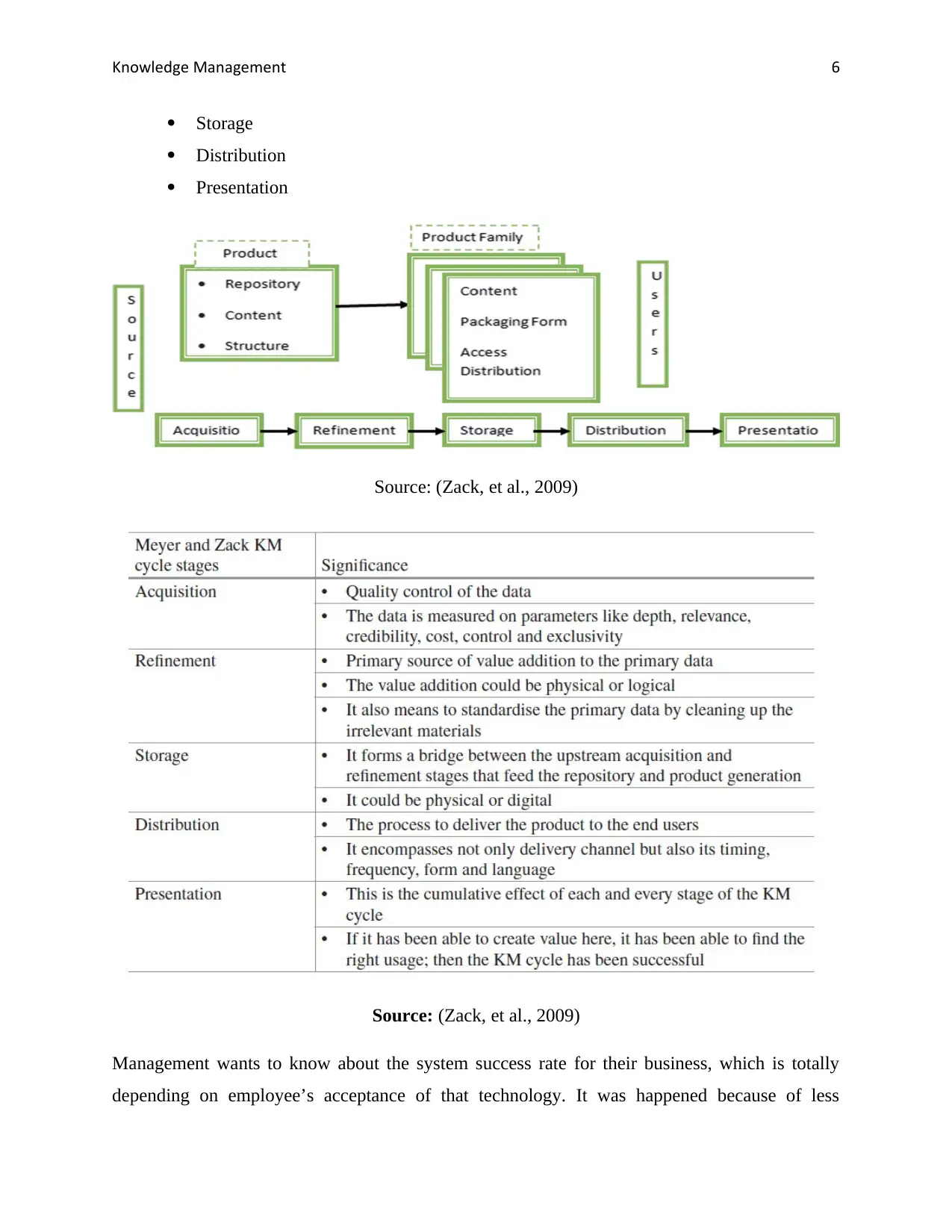
Knowledge Management 6
Storage
Distribution
Presentation
Source: (Zack, et al., 2009)
Source: (Zack, et al., 2009)
Management wants to know about the system success rate for their business, which is totally
depending on employee’s acceptance of that technology. It was happened because of less
Storage
Distribution
Presentation
Source: (Zack, et al., 2009)
Source: (Zack, et al., 2009)
Management wants to know about the system success rate for their business, which is totally
depending on employee’s acceptance of that technology. It was happened because of less
Paraphrase This Document
Need a fresh take? Get an instant paraphrase of this document with our AI Paraphraser
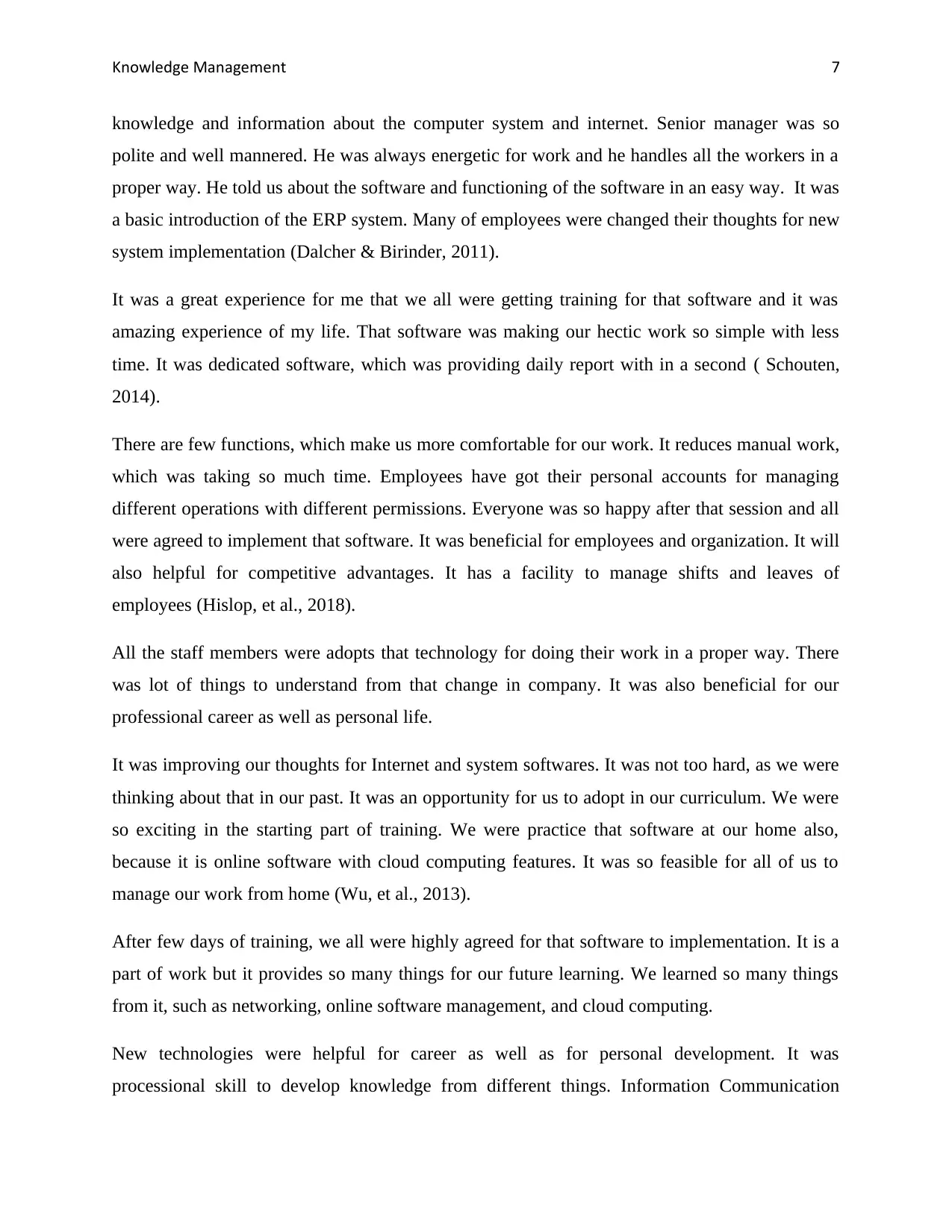
Knowledge Management 7
knowledge and information about the computer system and internet. Senior manager was so
polite and well mannered. He was always energetic for work and he handles all the workers in a
proper way. He told us about the software and functioning of the software in an easy way. It was
a basic introduction of the ERP system. Many of employees were changed their thoughts for new
system implementation (Dalcher & Birinder, 2011).
It was a great experience for me that we all were getting training for that software and it was
amazing experience of my life. That software was making our hectic work so simple with less
time. It was dedicated software, which was providing daily report with in a second ( Schouten,
2014).
There are few functions, which make us more comfortable for our work. It reduces manual work,
which was taking so much time. Employees have got their personal accounts for managing
different operations with different permissions. Everyone was so happy after that session and all
were agreed to implement that software. It was beneficial for employees and organization. It will
also helpful for competitive advantages. It has a facility to manage shifts and leaves of
employees (Hislop, et al., 2018).
All the staff members were adopts that technology for doing their work in a proper way. There
was lot of things to understand from that change in company. It was also beneficial for our
professional career as well as personal life.
It was improving our thoughts for Internet and system softwares. It was not too hard, as we were
thinking about that in our past. It was an opportunity for us to adopt in our curriculum. We were
so exciting in the starting part of training. We were practice that software at our home also,
because it is online software with cloud computing features. It was so feasible for all of us to
manage our work from home (Wu, et al., 2013).
After few days of training, we all were highly agreed for that software to implementation. It is a
part of work but it provides so many things for our future learning. We learned so many things
from it, such as networking, online software management, and cloud computing.
New technologies were helpful for career as well as for personal development. It was
processional skill to develop knowledge from different things. Information Communication
knowledge and information about the computer system and internet. Senior manager was so
polite and well mannered. He was always energetic for work and he handles all the workers in a
proper way. He told us about the software and functioning of the software in an easy way. It was
a basic introduction of the ERP system. Many of employees were changed their thoughts for new
system implementation (Dalcher & Birinder, 2011).
It was a great experience for me that we all were getting training for that software and it was
amazing experience of my life. That software was making our hectic work so simple with less
time. It was dedicated software, which was providing daily report with in a second ( Schouten,
2014).
There are few functions, which make us more comfortable for our work. It reduces manual work,
which was taking so much time. Employees have got their personal accounts for managing
different operations with different permissions. Everyone was so happy after that session and all
were agreed to implement that software. It was beneficial for employees and organization. It will
also helpful for competitive advantages. It has a facility to manage shifts and leaves of
employees (Hislop, et al., 2018).
All the staff members were adopts that technology for doing their work in a proper way. There
was lot of things to understand from that change in company. It was also beneficial for our
professional career as well as personal life.
It was improving our thoughts for Internet and system softwares. It was not too hard, as we were
thinking about that in our past. It was an opportunity for us to adopt in our curriculum. We were
so exciting in the starting part of training. We were practice that software at our home also,
because it is online software with cloud computing features. It was so feasible for all of us to
manage our work from home (Wu, et al., 2013).
After few days of training, we all were highly agreed for that software to implementation. It is a
part of work but it provides so many things for our future learning. We learned so many things
from it, such as networking, online software management, and cloud computing.
New technologies were helpful for career as well as for personal development. It was
processional skill to develop knowledge from different things. Information Communication
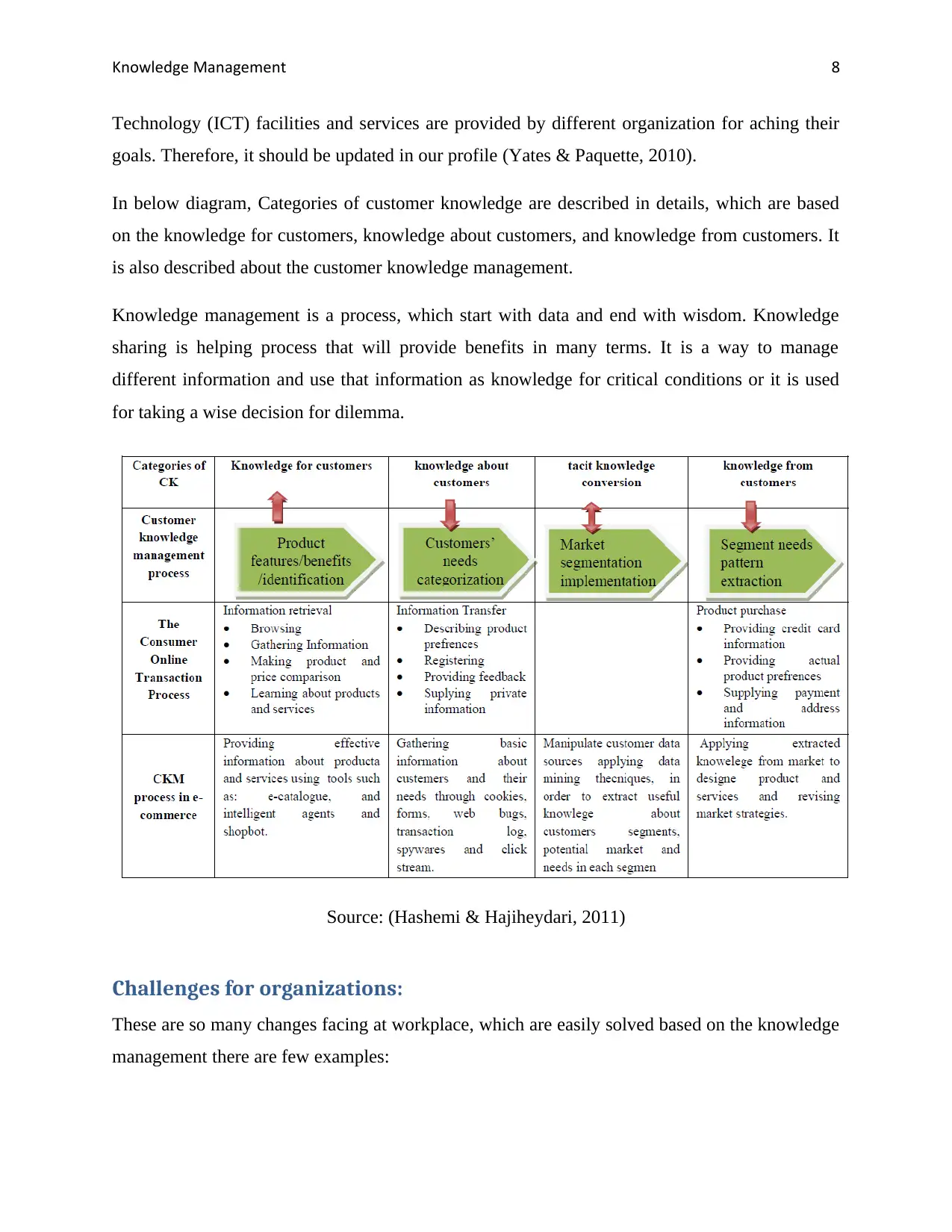
Knowledge Management 8
Technology (ICT) facilities and services are provided by different organization for aching their
goals. Therefore, it should be updated in our profile (Yates & Paquette, 2010).
In below diagram, Categories of customer knowledge are described in details, which are based
on the knowledge for customers, knowledge about customers, and knowledge from customers. It
is also described about the customer knowledge management.
Knowledge management is a process, which start with data and end with wisdom. Knowledge
sharing is helping process that will provide benefits in many terms. It is a way to manage
different information and use that information as knowledge for critical conditions or it is used
for taking a wise decision for dilemma.
Source: (Hashemi & Hajiheydari, 2011)
Challenges for organizations:
These are so many changes facing at workplace, which are easily solved based on the knowledge
management there are few examples:
Technology (ICT) facilities and services are provided by different organization for aching their
goals. Therefore, it should be updated in our profile (Yates & Paquette, 2010).
In below diagram, Categories of customer knowledge are described in details, which are based
on the knowledge for customers, knowledge about customers, and knowledge from customers. It
is also described about the customer knowledge management.
Knowledge management is a process, which start with data and end with wisdom. Knowledge
sharing is helping process that will provide benefits in many terms. It is a way to manage
different information and use that information as knowledge for critical conditions or it is used
for taking a wise decision for dilemma.
Source: (Hashemi & Hajiheydari, 2011)
Challenges for organizations:
These are so many changes facing at workplace, which are easily solved based on the knowledge
management there are few examples:
⊘ This is a preview!⊘
Do you want full access?
Subscribe today to unlock all pages.

Trusted by 1+ million students worldwide
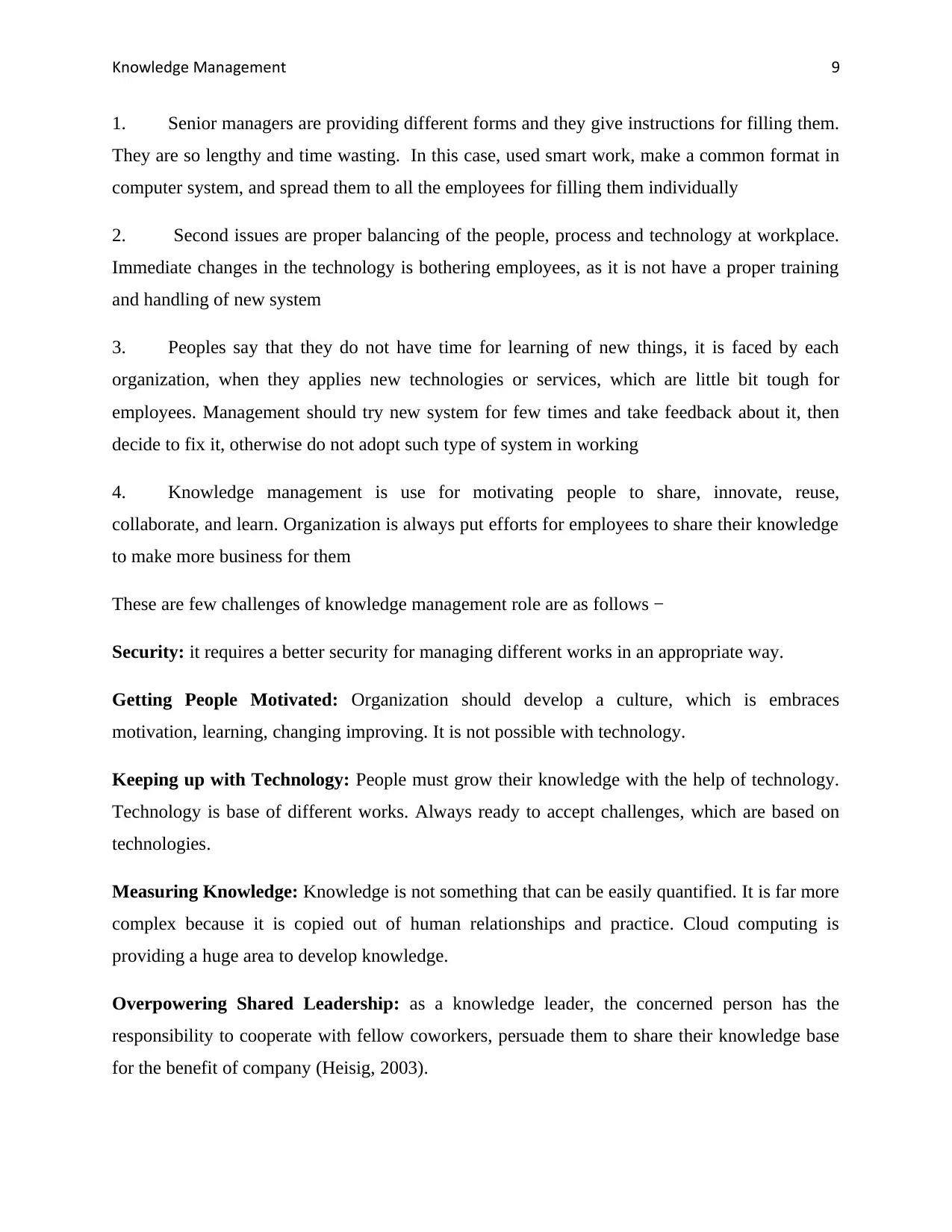
Knowledge Management 9
1. Senior managers are providing different forms and they give instructions for filling them.
They are so lengthy and time wasting. In this case, used smart work, make a common format in
computer system, and spread them to all the employees for filling them individually
2. Second issues are proper balancing of the people, process and technology at workplace.
Immediate changes in the technology is bothering employees, as it is not have a proper training
and handling of new system
3. Peoples say that they do not have time for learning of new things, it is faced by each
organization, when they applies new technologies or services, which are little bit tough for
employees. Management should try new system for few times and take feedback about it, then
decide to fix it, otherwise do not adopt such type of system in working
4. Knowledge management is use for motivating people to share, innovate, reuse,
collaborate, and learn. Organization is always put efforts for employees to share their knowledge
to make more business for them
These are few challenges of knowledge management role are as follows −
Security: it requires a better security for managing different works in an appropriate way.
Getting People Motivated: Organization should develop a culture, which is embraces
motivation, learning, changing improving. It is not possible with technology.
Keeping up with Technology: People must grow their knowledge with the help of technology.
Technology is base of different works. Always ready to accept challenges, which are based on
technologies.
Measuring Knowledge: Knowledge is not something that can be easily quantified. It is far more
complex because it is copied out of human relationships and practice. Cloud computing is
providing a huge area to develop knowledge.
Overpowering Shared Leadership: as a knowledge leader, the concerned person has the
responsibility to cooperate with fellow coworkers, persuade them to share their knowledge base
for the benefit of company (Heisig, 2003).
1. Senior managers are providing different forms and they give instructions for filling them.
They are so lengthy and time wasting. In this case, used smart work, make a common format in
computer system, and spread them to all the employees for filling them individually
2. Second issues are proper balancing of the people, process and technology at workplace.
Immediate changes in the technology is bothering employees, as it is not have a proper training
and handling of new system
3. Peoples say that they do not have time for learning of new things, it is faced by each
organization, when they applies new technologies or services, which are little bit tough for
employees. Management should try new system for few times and take feedback about it, then
decide to fix it, otherwise do not adopt such type of system in working
4. Knowledge management is use for motivating people to share, innovate, reuse,
collaborate, and learn. Organization is always put efforts for employees to share their knowledge
to make more business for them
These are few challenges of knowledge management role are as follows −
Security: it requires a better security for managing different works in an appropriate way.
Getting People Motivated: Organization should develop a culture, which is embraces
motivation, learning, changing improving. It is not possible with technology.
Keeping up with Technology: People must grow their knowledge with the help of technology.
Technology is base of different works. Always ready to accept challenges, which are based on
technologies.
Measuring Knowledge: Knowledge is not something that can be easily quantified. It is far more
complex because it is copied out of human relationships and practice. Cloud computing is
providing a huge area to develop knowledge.
Overpowering Shared Leadership: as a knowledge leader, the concerned person has the
responsibility to cooperate with fellow coworkers, persuade them to share their knowledge base
for the benefit of company (Heisig, 2003).
Paraphrase This Document
Need a fresh take? Get an instant paraphrase of this document with our AI Paraphraser
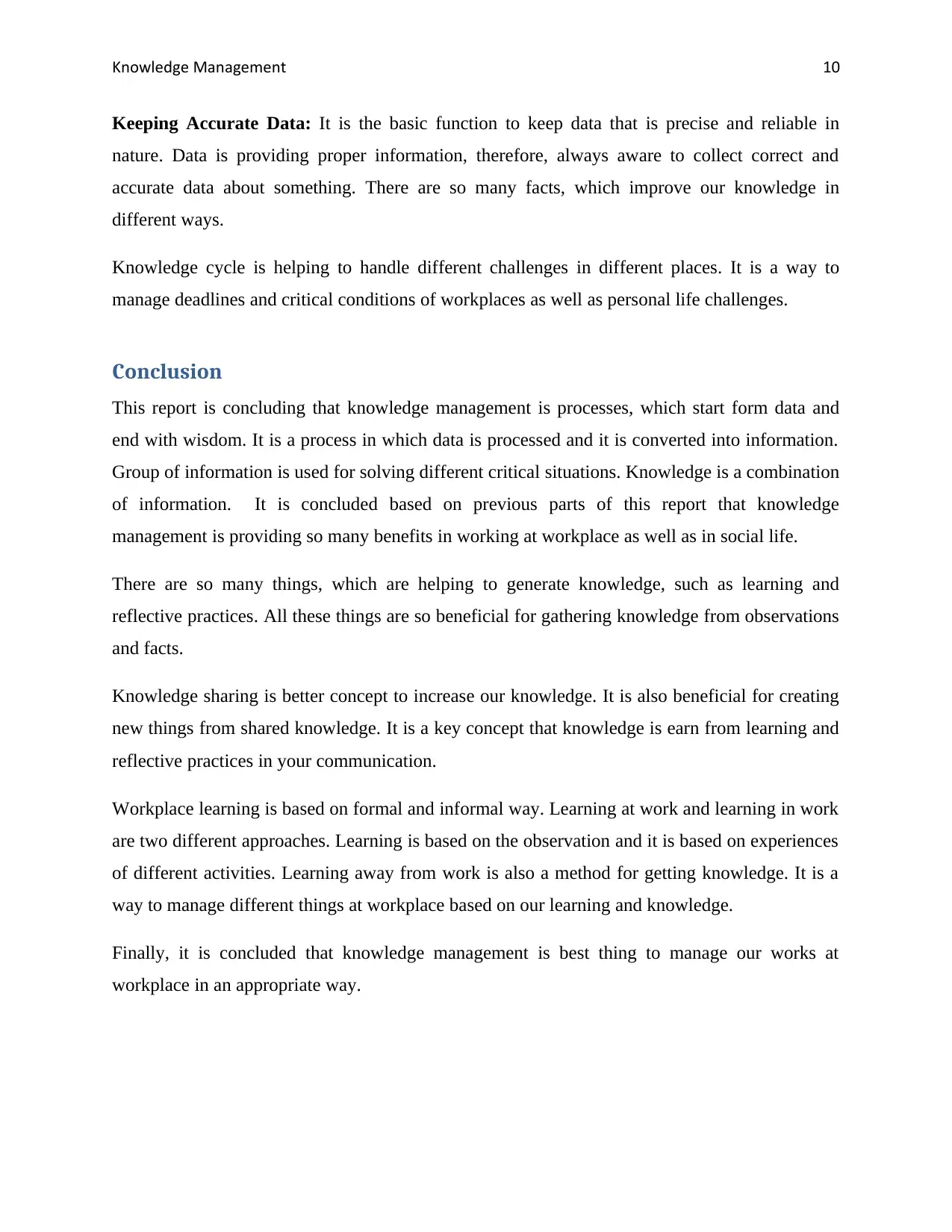
Knowledge Management 10
Keeping Accurate Data: It is the basic function to keep data that is precise and reliable in
nature. Data is providing proper information, therefore, always aware to collect correct and
accurate data about something. There are so many facts, which improve our knowledge in
different ways.
Knowledge cycle is helping to handle different challenges in different places. It is a way to
manage deadlines and critical conditions of workplaces as well as personal life challenges.
Conclusion
This report is concluding that knowledge management is processes, which start form data and
end with wisdom. It is a process in which data is processed and it is converted into information.
Group of information is used for solving different critical situations. Knowledge is a combination
of information. It is concluded based on previous parts of this report that knowledge
management is providing so many benefits in working at workplace as well as in social life.
There are so many things, which are helping to generate knowledge, such as learning and
reflective practices. All these things are so beneficial for gathering knowledge from observations
and facts.
Knowledge sharing is better concept to increase our knowledge. It is also beneficial for creating
new things from shared knowledge. It is a key concept that knowledge is earn from learning and
reflective practices in your communication.
Workplace learning is based on formal and informal way. Learning at work and learning in work
are two different approaches. Learning is based on the observation and it is based on experiences
of different activities. Learning away from work is also a method for getting knowledge. It is a
way to manage different things at workplace based on our learning and knowledge.
Finally, it is concluded that knowledge management is best thing to manage our works at
workplace in an appropriate way.
Keeping Accurate Data: It is the basic function to keep data that is precise and reliable in
nature. Data is providing proper information, therefore, always aware to collect correct and
accurate data about something. There are so many facts, which improve our knowledge in
different ways.
Knowledge cycle is helping to handle different challenges in different places. It is a way to
manage deadlines and critical conditions of workplaces as well as personal life challenges.
Conclusion
This report is concluding that knowledge management is processes, which start form data and
end with wisdom. It is a process in which data is processed and it is converted into information.
Group of information is used for solving different critical situations. Knowledge is a combination
of information. It is concluded based on previous parts of this report that knowledge
management is providing so many benefits in working at workplace as well as in social life.
There are so many things, which are helping to generate knowledge, such as learning and
reflective practices. All these things are so beneficial for gathering knowledge from observations
and facts.
Knowledge sharing is better concept to increase our knowledge. It is also beneficial for creating
new things from shared knowledge. It is a key concept that knowledge is earn from learning and
reflective practices in your communication.
Workplace learning is based on formal and informal way. Learning at work and learning in work
are two different approaches. Learning is based on the observation and it is based on experiences
of different activities. Learning away from work is also a method for getting knowledge. It is a
way to manage different things at workplace based on our learning and knowledge.
Finally, it is concluded that knowledge management is best thing to manage our works at
workplace in an appropriate way.
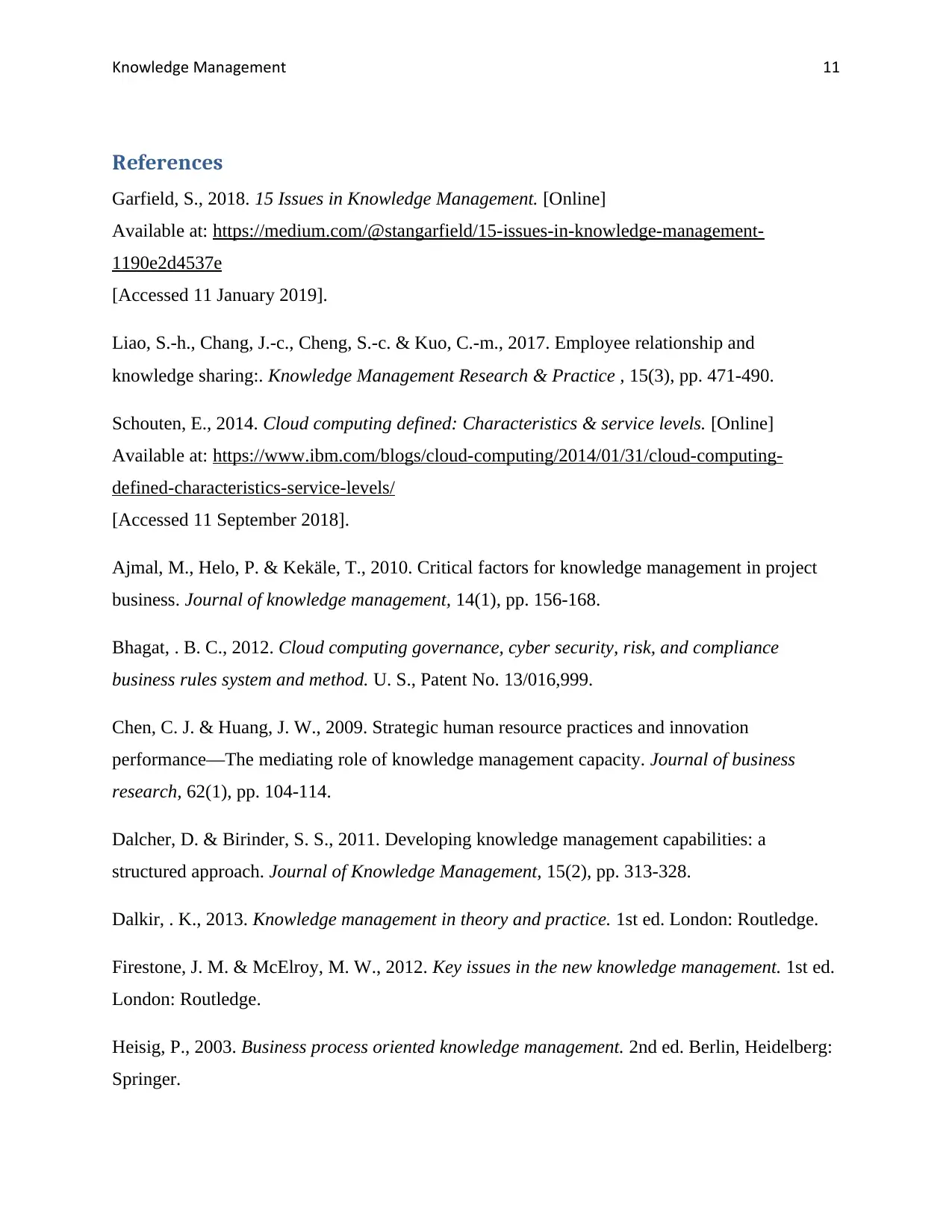
Knowledge Management 11
References
Garfield, S., 2018. 15 Issues in Knowledge Management. [Online]
Available at: https://medium.com/@stangarfield/15-issues-in-knowledge-management-
1190e2d4537e
[Accessed 11 January 2019].
Liao, S.-h., Chang, J.-c., Cheng, S.-c. & Kuo, C.-m., 2017. Employee relationship and
knowledge sharing:. Knowledge Management Research & Practice , 15(3), pp. 471-490.
Schouten, E., 2014. Cloud computing defined: Characteristics & service levels. [Online]
Available at: https://www.ibm.com/blogs/cloud-computing/2014/01/31/cloud-computing-
defined-characteristics-service-levels/
[Accessed 11 September 2018].
Ajmal, M., Helo, P. & Kekäle, T., 2010. Critical factors for knowledge management in project
business. Journal of knowledge management, 14(1), pp. 156-168.
Bhagat, . B. C., 2012. Cloud computing governance, cyber security, risk, and compliance
business rules system and method. U. S., Patent No. 13/016,999.
Chen, C. J. & Huang, J. W., 2009. Strategic human resource practices and innovation
performance—The mediating role of knowledge management capacity. Journal of business
research, 62(1), pp. 104-114.
Dalcher, D. & Birinder, S. S., 2011. Developing knowledge management capabilities: a
structured approach. Journal of Knowledge Management, 15(2), pp. 313-328.
Dalkir, . K., 2013. Knowledge management in theory and practice. 1st ed. London: Routledge.
Firestone, J. M. & McElroy, M. W., 2012. Key issues in the new knowledge management. 1st ed.
London: Routledge.
Heisig, P., 2003. Business process oriented knowledge management. 2nd ed. Berlin, Heidelberg:
Springer.
References
Garfield, S., 2018. 15 Issues in Knowledge Management. [Online]
Available at: https://medium.com/@stangarfield/15-issues-in-knowledge-management-
1190e2d4537e
[Accessed 11 January 2019].
Liao, S.-h., Chang, J.-c., Cheng, S.-c. & Kuo, C.-m., 2017. Employee relationship and
knowledge sharing:. Knowledge Management Research & Practice , 15(3), pp. 471-490.
Schouten, E., 2014. Cloud computing defined: Characteristics & service levels. [Online]
Available at: https://www.ibm.com/blogs/cloud-computing/2014/01/31/cloud-computing-
defined-characteristics-service-levels/
[Accessed 11 September 2018].
Ajmal, M., Helo, P. & Kekäle, T., 2010. Critical factors for knowledge management in project
business. Journal of knowledge management, 14(1), pp. 156-168.
Bhagat, . B. C., 2012. Cloud computing governance, cyber security, risk, and compliance
business rules system and method. U. S., Patent No. 13/016,999.
Chen, C. J. & Huang, J. W., 2009. Strategic human resource practices and innovation
performance—The mediating role of knowledge management capacity. Journal of business
research, 62(1), pp. 104-114.
Dalcher, D. & Birinder, S. S., 2011. Developing knowledge management capabilities: a
structured approach. Journal of Knowledge Management, 15(2), pp. 313-328.
Dalkir, . K., 2013. Knowledge management in theory and practice. 1st ed. London: Routledge.
Firestone, J. M. & McElroy, M. W., 2012. Key issues in the new knowledge management. 1st ed.
London: Routledge.
Heisig, P., 2003. Business process oriented knowledge management. 2nd ed. Berlin, Heidelberg:
Springer.
⊘ This is a preview!⊘
Do you want full access?
Subscribe today to unlock all pages.

Trusted by 1+ million students worldwide
1 out of 13
Related Documents
Your All-in-One AI-Powered Toolkit for Academic Success.
+13062052269
info@desklib.com
Available 24*7 on WhatsApp / Email
![[object Object]](/_next/static/media/star-bottom.7253800d.svg)
Unlock your academic potential
Copyright © 2020–2025 A2Z Services. All Rights Reserved. Developed and managed by ZUCOL.




